If you want to know how to loosen tight muscles, the self-myofascial release (SMR) technique can help! Using a foam roller, you can increase joint range of motion and ease tension in tight muscles all over your body. Foam rolling can also help reduce inflammation. Foam rolling has become the way to perform self-myofascial release—a fancy term for self-massage to release muscle tightness or trigger points. Basically, by applying pressure to specific points on your body, you can help your muscles recover. Of course, getting a deep tissue massage is a nice way to go too, but it takes a lot of time and gets very expensive.
Why Use Self Myofascial Release?
SMR focuses on the neural and fascial systems in the body that can be negatively influenced by poor posture, repetitive motions, or dysfunctional movements.
These mechanically stressful actions are recognized as an injury by the body, initiating a repair process called the Cumulative Injury Cycle. SMR is based on the principle of autogenic inhibition. When the body’s pressure against the foam roller is sustained on the trigger point, it will “turn off” the muscle spindle activity allowing the muscle fibers to stretch, unknot, and realign. A reduction of pain SMR often accompanies this release.
For as little as $25 you can find a basic foam roller and in 10 minutes, begin that well-needed release your muscles need to stay pain-free.
Take a look at all the awesome health benefits of foam rolling and get some more tips if you’re new to foam rolling.
Guidelines Before You Start Foam Rolling
Foam rolling activities should be done on muscles and tissues you identify as tight, stressed, or overactive. Most people can enjoy foam rolling on their own once instructed on how to properly perform the exercises.
During the exercises, it is important to maintain core stability. Use the drawing-in maneuver (pulling the navel in toward the spine) to maintain stability.
6 Foam Roller Moves To Loosen Tight Muscles
[adthrive-in-post-video-player video-id=”Oo2MSLMQ” upload-date=”2019-06-06T20:57:33.000Z” name=”6 Foam Roller Moves to Relieve Tight Muscles ” description=”If your muscles are in knots and feeling tight, the foam roller might be the easiest fix you’ve ever found. Try these 6 moves to loosen tight muscles!”]
Here are six simple foam rolling moves that cover the majority of common muscle issues.
For each move, spend at least 30 seconds rolling slowly and gently, and if you find a “knot” or trigger point in the muscle you are rolling, stop for a few seconds and let the roller apply pressure to that spot.
It will be uncomfortable initially, but keep breathing and let the roller do its work. Momentary discomfort will lead to long-term relief!
It will also make future workouts better and prevent injury in the long run.
How to Foam Roll Your Back
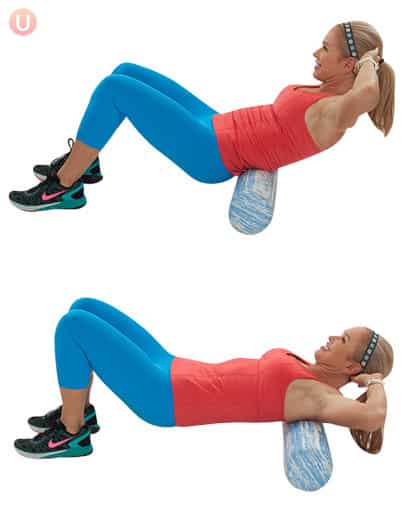
2) Walk your feet slowly forward as the roller glides up your back. Stop and concentrate on any tight areas. (Note: do not foam roll the low back. Try a massage ball on either side of the spine to help relieve tight muscles.)
3) Move forward and back for 30-60 seconds.
How to Foam Roll Calves
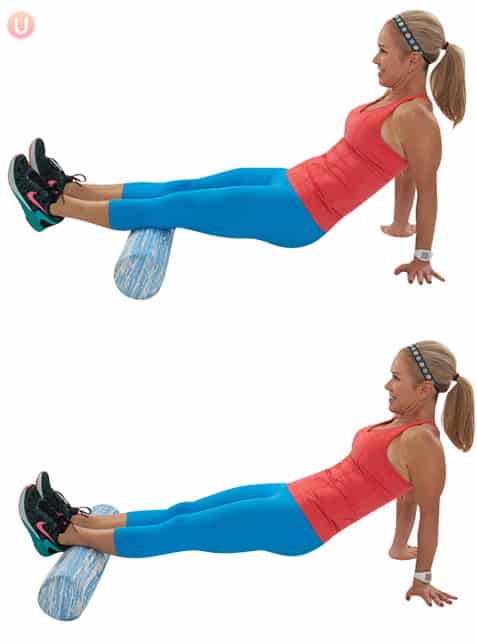
2) Lift your hips off the ground and slowly pull your body backward, so the roller glides up your calf. Move back and forth gently for 30 seconds, stopping at any tight areas.
How to Foam Roll Hamstrings
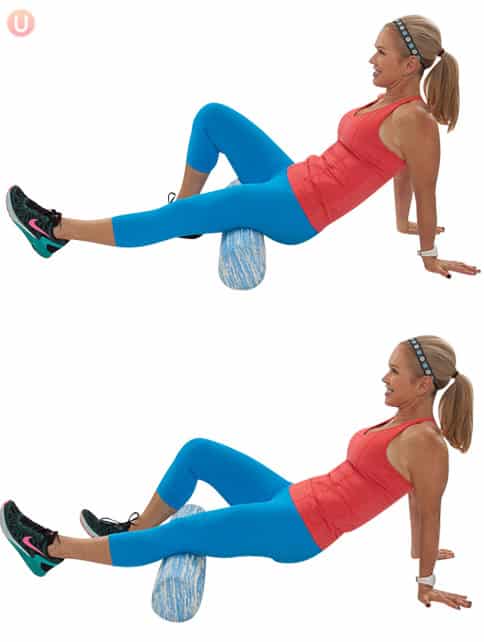
2) Keep the right leg relaxed and long with the left knee bent over the roller and the left foot on the ground.
2) Begin to press into the left foot on the ground, slowly moving the body back as the foam roller rolls down the right hamstring. Keep your right leg relaxed as you roll.
3) Glide up and down the muscle for 30-60 seconds, concentrating on any tighter areas.
4) Switch sides.
Get More Hamstring Relief: Hamstring Stretch Routine To Loosen Tightness
How to Foam Roll Your IT Band
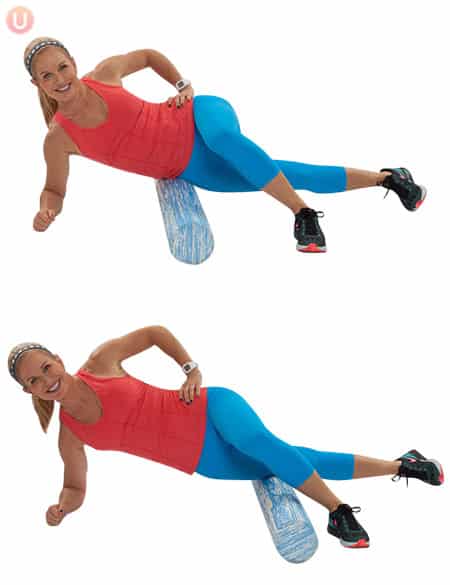
2) Bend the left knee and place the left foot in front of the right foot.
3) Relax your right leg as you slowly roll yourself back, so the foam roller glides up your leg. Move gently back and forth for 30-60 seconds, concentrating on any tight areas.
4) Switch sides.
How to Foam Roll Lats
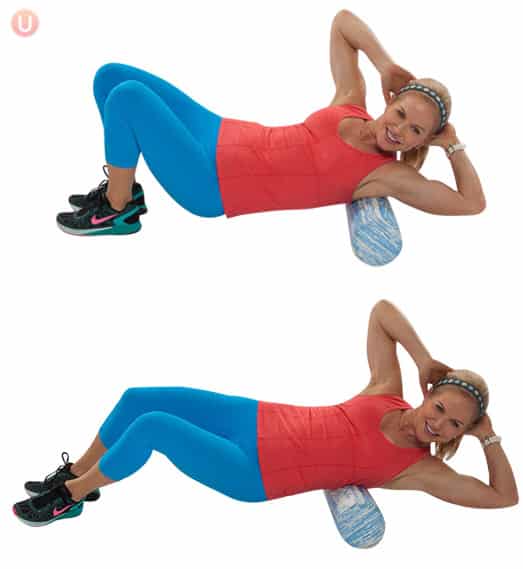
2) Twisting slightly to the right, push slowly into your feet so your body begins to move back, and the roller glides down along your lats on the right. Return slowly to start.
2) Repeat for 30-60 seconds concentrating on any tight areas.
4) Switch sides.
How to Foam Roll Quads
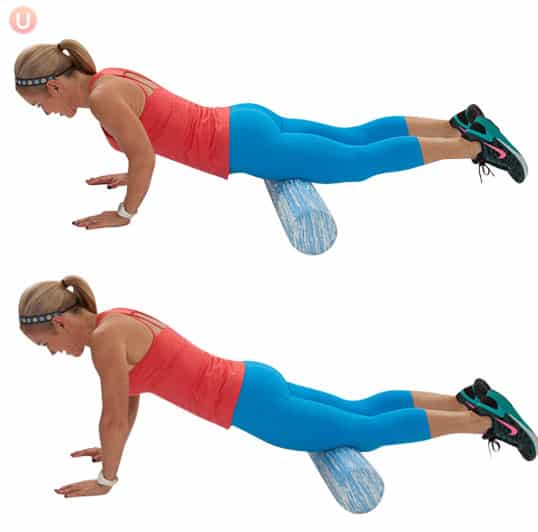
2) Slowly press arms to be straight, pulling the body upward and forward so the foam roller glides across the front of the thighs.
3) If you choose, you can lean your body weight onto one leg and roll and then switch to the other instead of rolling both evenly.
4) Gently continue to push and pull the roller over the thighs for 30-60 seconds, concentrating on any tight areas.
Try these rolling moves before and/or after any workout, or use them at home any time you need to release your tightness or knots. You can do them daily, but 2-3 times a week is recommended.
Foam Rolling FAQs
Who foam rolling is best for:
Foam rolling and self-myofascial release (SMR) is for most people. Some conditions contraindicate the practice; however, when in doubt, check with a professional for any potential health conditions. Foam rollers are good for anyone who sits a lot and moves a lot and anyone who loves to work out a lot.
Should you foam roll before or after a workout?
The question is often raised as to whether foam rolling before a workout or after would be better.
And the answer is pretty straightforward: You should definitely take some time to foam roll before your workout, and then you could consider rolling out the knots after your workout with the help of a roller.
You will gain the most benefit from foam rolling by doing it before a workout, though.
What about vibrating foam rollers?
The effects of adding vibrating foam rollers to SMR remain unstudied. Vibrating foam rollers often cost double the price of traditional foam rollers. However, vibration may simply feel good on your muscles. If you like vibration, you also may be more inclined to foam roll for longer.
What are the best foam rollers on Amazon?
- High Density (different length) Foam Roller
- Trigger Point Foam Roller
- Medium Density Foam Roller
- Electric Foam Roller
- Trigger Point Massage Ball – I use this daily for my low back pain routine. Great for targeted areas!
- Hyperice Sphere Massage Ball
- Massage Roller Stick
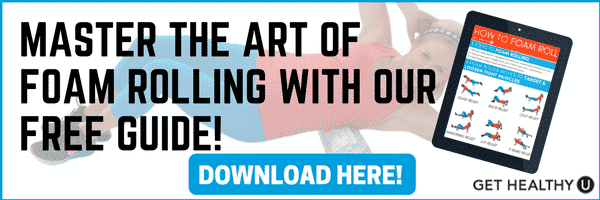

12 Comments
Uzma Ali on October 3, 2021 at 11:37 AM
Does foam roller permanently help to stop stiffness in the muscles if used everyday before and after exercise for the calf muscles of the leg? I am looking for a permanent solution that would make my muscles work normally in the long-run. Please let me know. I am searching up answers but cannot find them. My email is aliu45126@gmail.com Thanks
Chris Freytag, CPT on October 14, 2021 at 2:00 PM
Hi There - So foam rolling or the self-myofascial release (SMR) technique can help relieve sore muscles. It can increase joint range of motion and ease tension in the body part that you are foam rolling. It can also decrease inflammation in the body as well. Basically, by applying pressure to specific points on your body you are able to help your muscles recover. Now, it will not "permanently" stop stiffness in the muscles, but it will help your body to recover faster if you're using everyday before and after a long run. If you use it before a workout, you are loosening the muscles and getting them ready to work. After a workout, you are preventing the muscles from stiffening up and keeping the blood flowing after a workout. Let me know if you have any other questions!
MARIE RAMSEY on July 2, 2018 at 11:56 PM
I actually use a pizza roller and roll my legs and thighs after i get out of the shower. I can always tell what area of my thighs need to be rolled more by the tension and how it feels. It is not only good for circulation it flattens out cellulite and prevents the fat from balling up. My friends are amazed how smooth it makes your legs. If you compare each leg you can actually see the difference in smoothness. I would love to try the big soft roller for hard to reach back areas and during stretching.
Barb on April 14, 2018 at 6:50 PM
My sister is having a terrible time with sciatica. Would this help her?
Chris Freytag on April 16, 2018 at 9:20 AM
Hi Barb - that depends! I'd recommend she speak to her doctor or a personal trainer based on her specific pain/injury. Foam rolling can definitely help with sciatica pain however, there are certain causes of pain, such as a herniated disc that make it so you should NOT foam roll as this can actually cause it to become worse. So, again it just depends on her specific injury so I'd encourage her to speak with someone about her specific case and whether or not foam rolling could be helpful or harmful.
Liz on January 24, 2018 at 3:33 AM
I have been using the form roller in my lower back and enjoyed it. I guess now I have to use it according to what I read above. I have found form rolling is fantastic .
Diane on March 23, 2017 at 2:12 PM
I've used the foam roller on my low back and loved it, but recently I read another article that said you should not roll the low back because the kidneys are there. Do you feel that it is ok? I never experienced any problems doing it and it always felt good, but I stopped.
Chris Freytag on March 23, 2017 at 7:40 PM
Yes - you are right - rolling directly on the 5 lumbar is not recommended. In the back roll photos in this article - it’s the mid to upper back I was rolling. Often suggested is using a massage ball (like a lacrosse ball) on either side of the low back to help relieve tight muscles - I actually do that everyday for my back. That being said - with a soft foam roller - I see lots of people rolling their low back at the gym and I have never heard anyone say they hurt themselves from it. SO it depends on the firmness of your roller - but you are right it isn’t recommended.
Mary on August 23, 2015 at 7:30 PM
It would be nice to print the article with the pictures in place. There are ways to do it but you have it so it is quite difficult
Sarah on September 22, 2017 at 12:57 PM
Totally agree with you!! it's super frustrating to have this information only accessible online and it won't print with the current layout. I wish they would fix this!!!
Chris Freytag on September 26, 2017 at 1:09 PM
Hi again – we heard your request and have now enabled the images to be printed! Hope that helps!
Chris Freytag on September 25, 2017 at 1:37 PM
Hi Sarah and Mary - we're so sorry you're having issues. We are looking into it and will hopefully be able to fix it/give you an answer soon!